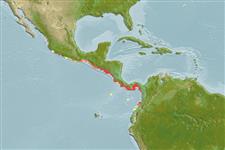>
Blenniiformes (Blennies) >
Chaenopsidae (Pike-, tube- and flagblennies)
Etymology: Chaenopsis: Greek, chaeno = to yawn + Greek, opsis = appearance (Ref. 45335).
Environment: milieu / climate zone / depth range / distribution range
Ecologia
marino demersale; distribuzione batimetrica 4 - 30 m (Ref. 11482). Tropical
Eastern Central Pacific: Costa Rica to Colombia.
Size / Peso / Age
Maturity: Lm ? range ? - ? cm
Max length : 7.5 cm TL maschio/sesso non determinato; (Ref. 11482)
Inhabits worm tubes on sand-rubble bottoms. Feeds on zooplankton (Ref. 11482). Minimum depth from Ref. 58018.
Life cycle and mating behavior
Maturità | Riproduzione | Deposizione | Uova | Fecundity | Larve
Allen, G.R. and D.R. Robertson, 1994. Fishes of the tropical eastern Pacific. University of Hawaii Press, Honolulu. 332 p. (Ref. 11482)
IUCN Red List Status (Ref. 130435: Version 2024-1)
Threat to humans
Harmless
Human uses
Strumenti
Special reports
Download XML
Fonti Internet
Estimates based on models
Preferred temperature (Ref.
123201): 27 - 29.1, mean 28.2 °C (based on 144 cells).
Phylogenetic diversity index (Ref.
82804): PD
50 = 0.5010 [Uniqueness, from 0.5 = low to 2.0 = high].
Bayesian length-weight: a=0.00102 (0.00046 - 0.00225), b=3.06 (2.88 - 3.24), in cm total length, based on all LWR estimates for this body shape (Ref.
93245).
Trophic level (Ref.
69278): 3.4 ±0.45 se; based on food items.
Fishing Vulnerability (Ref.
59153): Low vulnerability (10 of 100).
